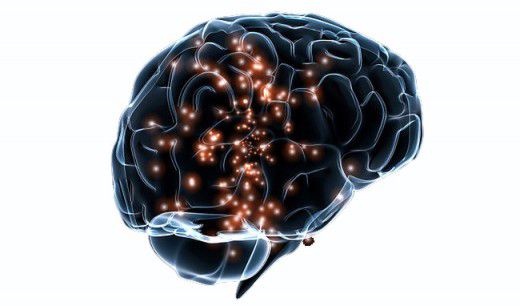Can cognitive science find the areas of the brain that make us religious?

Religion is a ubiquitous cultural phenomenon that has inspired and perplexed philosophers, psychologists, and social commentators for centuries. The cognitive science of religion is the most recent attempt to decipher its role in the world. It puts aside theistic and atheistic biases, and tries to understand the psychology underpinning religious thought, belief, and behavior.
The cognitive science of religion asks why religion is cross-culturally popular, which cognitive mechanisms ensure its popularity, how did they evolve, and which psychological traits dispose us to belief? Of principle concern is how religion became so pervasive when its associated behavior is a costly use of time and resources. Would natural selection favor such wasteful endeavor, or is our tendency to piety a byproduct of other adaptive traits? The following sections summarize key findings in the cognitive science of religion.
1. Gods Capture our Attention and Memory
Some stories are so memorable that they resonate within cultures for millennia.Pascal Boyer and Charles Ramble suggested that stories which violate our intuitions about the world are particularly captivating and memorable. They performed an experiment to compare the memorability of intuitive and counterintuitive objects. The counterintuitve items included such things as a living person built from plaster, and objects that don't like you staring at them. They found that people from several different cultures were more likely to remember the counterintuitive objects.
Boyer and Ramble surmised that religions enjoy a cultural advantage because their counterintuitive gods are attention-grabbing and memorable. However, the experimenters discovered an optimum level of bizarreness. Objects that are too counterintuitive are not well remembered, but objects that are minimally counterintuitive are `just right'. For example, a god that is emotionally and physically human, but which can read your mind and pass through walls is more likely to be remembered than a god with no human features. Inclusion of these mundane characteristics makes the god memorable because it allows inferences to be drawn about what the god is thinking, how it will behave, and how it will impact human life. Boyer and others have remarked that many religions employ such gods.

Minimally counter intuitive gods capture our attention and are memorable.
2. Hyperactive Agency Detection Device (HADD)
A rustle in the bushes could be caused by a gust of wind or a falling branch. A noise in an old house could be caused by cooling pipes or a tree brushing against the structure. What it usually isn't is a monster or a poltergeist. However, the human brain is wired to predict the presence of a purposeful agent that caused the disturbance. An explanation for this superstitious behavior can be found in our ancestral past, where people who made more false-positives about potential threats were more likely to survive. This is because the cost of assuming a threat is negligible, while the cost of failing to detect a threat could be fatal. Simply put, it's better to be safe than sorry! As a result, natural selection appears to have endowed humans with an agency detection device that is hyperactive.
As well as monsters and poltergeists, we'll chide `lady luck' when we experience misfortune, complain about gremlins in our machines when something breaks, and anthropomorphize animals and objects. Gods may be another example of our propensity to invent agency. Our need to understand the causes of miraculous and distressing events could lead us to see faces in the clouds and devils in the shadows.
The cognitive science of religion frequently draws on studies and findings from psychology, neuroscience, and evolutionary biology. However, it is a collaborative field, accommodating data from anthropology, philosophy, artificial intelligence, ethology, and the social sciences.
3. Anthropomorphism is Involuntary
Justin Barrett and Frank Keil discovered that people often try to make sense of counterintuitive gods by anthropomorphizing them. They asked 145 college students about their theological beliefs. Most described their god as perfectly omnipotent, omniscient, atemporal, and omnipresent; in line with what is prescribed by many religious traditions.
However, when asked to remember and comprehend narratives about God's actions in the world, people used anthropomorphic concepts that were inconsistent with their stated beliefs. God was given a physical form, with human senses, emotions, likes, and dislikes; his attention was limited to one location, he could be distracted by noise, and he was only capable of performing one action at a time. People involuntarily distorted the narratives, and consistently misremembered their stated beliefs in favor of these more intuitive, anthropomorphic ideas. When their stated beliefs were highlighted by the experimenters, anthropomorphism reduced.
This tendency to anthropomorphize is probably caused by a "theory of mind" module in the human brain. This evolved to help us infer the desires, beliefs, and intentions of people who might deceive us. However, much like the HADD and our intrigue for counterintuitive objects, the module appears to have been co-opted by religion, giving our gods an all-too-human personality.
See the video: https://youtu.be/KfUbRn9H2ac
4. Religious Concepts Are Easily Communicated
Building on the notion of memes, Dan Sperber explained how popular religious content is typically accompanied by evolved cognitive biases that cause us to attend to, remember, and communicate it. Our tendency to remember minimally counterintuitive objects or to invent intentional agents are examples of cognitive biases that help to spread religious content. Contrary to memetic theory, this content isn't usually transmitted intact, but is transformed by an individual's existing beliefs, biases, and desires (like Chinese whispers). Furthermore, if this content is accompanied by public representations and institutions, it will receive further advantages. Thus, public displays of devotion, churches, and other social, political, and educational institutions all serve to spread religious ideas.
Of key importance is how minimally counterintuitive (MCI) gods violate some of our intuitions, but confirm others via their mundane or anthropomorphized characteristics. This compromise allows us to infer the moods, desires, and intentions of our gods within coherent narratives that can be easily communicated. Scott Atran and Ara Norenzayan found that many religious narratives optimally relate a majority of factual, mundane, or intuitive information, with relatively few mentions of miraculous events.
Another factor that makes religion popular is the emotion elicited during rituals and worship. Intense emotion focuses the mind on its causes, making the experience memorable. Harvey Whitehouse found that rituals performed less frequently required an especially emotional experience to ensure their popularity.

5. Dual Inheritance Theory
If useful information such as social norms and moral rules (e.g. love thy neighbor) is included in a narrative, the information receives a transmission advantage if the story includes a minimally counterintuitive object. Religious narratives may therefore increase the commonality of adaptive, pro-social information. This co-opting of evolved cognitive biases for an alternative, social role is an example of Dual Inheritance Theory.
The evidence suggests that this interplay between genes and culture is quite intricate. For example, we may have evolved new cognitive biases that encourage religious belief for socially beneficial reasons. The following sections provide some examples.
6. Religion Provides Social Advantages
Azim Shariff and Ara Norenzayan found that unconsciously priming people to think about gods, spirits, and prophets made them more likely to be generous in an economic game. Another compelling example emerged in the work of Jesse Bering. He found that when people were left alone to play a game, they were less likely to cheat when told a ghost was in the room with them. A further study looked at how religious rituals can motivate pro-social behavior. The researchers found that painful rituals in particular led to more charitable giving by participants and observers of the ritual.
These studies suggest humans have evolved to consider the existence of punitive supernatural agents, and to respond with increased displays of moral, pro-social, and cooperative behavior. This is likely to be adaptive, meaning it provides advantages that aid the survival of its adherents and the groups they belong to.
7. Religious Symbols, Cooperation, and Morality
Religions generate widespread consensus and commitment to a prescribed set of beliefs, ideas, and rituals. This lack of epistemic diversity within religious groups leads to increased cooperation, friendship, loyalty, and other pro-social benefits. Such groups often adopt special symbols, tattoos, dress-codes, and modes of greeting that serve as artificial cues of kinship. This reinforces group bonds and helps them to identify outsiders. It also advertises their special alliance to potential collaborators.
The consensus found in religious groups naturally leads to agreement on moral issues. The group is able to form an unambiguous moral code, while individual believers receive an added incentive to behave morally to avoid supernatural punishment. This efficient path to collective obedience appears to be an adaptive advantage enjoyed by religious groups and civilizations.
8. Costly Displays of Commitment
A key question in the cognitive science of religion is: why do people devote time and resources to costly religious rituals or acts of worship that appear to have no adaptive use? Richard Sosis and Joseph Bulbulia suggest a solution called costly signalling theory in which religion's onerous practices demonstrate a performer's genuine commitment to their beliefs. This costly behavior signals to others that the performer is loyal to their community and will not abandon their commitment to cooperate. The community therefore benefits from an easy way to distinguish contributors from free-riders.
Sosis and Bulbulia argue for something called "niche construction" in which widespread costly signalling gradually pushes a community towards greater cooperation. For example, Emma Cohen and others found that religious rituals involving group-synchronous movement increased people's willingness to cooperate with each other and with non-participants. Such movements might include praying, singing, drumming, or dancing in unison. They determined thatsynchrony alone isn't enough, and that a religious context is essential for seeing increased cooperation.
Other researchers claim that costly displays can bring in new believers too.Joseph Henrich suggests that cultural learners evolved to detect these costly signals as evidence of the credibility of the performer's beliefs. In the ancestral past, cultural learning would have been exploited by individuals who held one belief but espoused another. Henrich proposes that learners detect costly behavior, which he calls "credibility enhancing displays", and use it to assess how credible the performer's belief is, and thus, how much to commit to it.

9. Religion and the Fear of Death
Jesse Bering found that people intuitively attribute emotions, desires, and beliefs to the dead. For example, they'll say a dead person still loves his wife, believes his wife loves him, and wants to be alive. However, they're far less likely to attribute biological qualities to the dead, such as hunger, thirst, sensory perception, or a functional brain. This disparity appears to be caused by an intuitive belief that an essence or soul that encapsulates the important, psychological aspects of one's being survives death. Thus, it may be natural to believe in an afterlife, and to utilize one's `theory of mind' to imagine a disembodied location for our thoughts, beliefs, and desires.
A connection between this research and our intrigue for counterintuitive agents is apparent. As death is inescapable in our intuitive world, religious, paranormal, and superstitious beliefs offer a unique opportunity. By definition, counterintuitive agents circumvent the laws of reality, meaning they could provide their human allies with a way to circumvent death.
10. Existential Anxiety and Terror Management
Anxiety is elicited when an uncontrollable or uncertain threat looms on the horizon. It's an unpleasant emotion that motivates precautionary behavior to restore control or certainty to the situation. Death is best described as an `existential anxiety' for this reason, and religious belief may be one way to restore control.
Many `mortality salience' experiments have measured the effects of existential anxiety on levels of religious belief. For example, Ara Norenzayan and Ian Hansenasked people to think about what would happen to them when they die. Afterwards, people's level of belief in gods and other supernatural agents increased. Some studies have replicated these results, finding increased belief among believers and atheists alike, but others found that atheists showed reduced belief in gods after thinking about death. Terror Management Theory claims this is because atheists are responding to death anxiety with `worldview defense'. Reducing their belief in deities reinforces their worldview, providing an alternative source of comfort.
Jamin Halberstadt and Jonathan Jong sought to understand the contradictory results. They confirmed that existential anxiety causes atheists to exhibit worldview defense when asked about explicit measures of religious belief, but, for implicit measures, there was a universal increase. Implicit beliefs operate automatically below the level of conscious awareness. For example, an atheist might explicitly deny the existence of souls and a higher power, but they'll still be reluctant to sell their soul to someone, and will describe important events as having a hidden meaning that taught them something significant. Jesse Bering's research into how people believe thoughts, desires, and emotions survive death, or how we cheat less when told a supernatural agent is watching us, are further examples of implicit beliefs that are at odds with explicitly held atheistic beliefs.
It is implicit, unconscious, religious beliefs such as these that appear to be strengthened by existential anxiety. Future research may attempt to understand why explicit religious beliefs are also sometimes strengthened.
11. Other Anxieties Increase Religious Belief
Death isn't the only peril that can alter beliefs. Ian McGregor found that asking a group of people to read and comprehend a difficult passage about statistics was enough to make them anxious about looking foolish. The participants subsequently displayed greater religious beliefs and superstitions than a control group. A different experiment made people anxious by asking them to remember uncontrollable events from their past. This lack of control led to increased belief in God as a controlling entity.
Neuroscience is a field that ties psychology to biological processes. An experiment by Michael Inzlicht and his team found that asking people about their religious beliefs led to reduced distress when making errors during a subsequent Stroop task. They measured levels of distress by looking at the anterior cingulate cortex, and saw less activity in response to errors when compared with a control group.
Another compelling study revealed that countries with less welfare (existential security) have higher levels of religious participation. Other investigations have discovered that negative emotions such as grief, guilt, and stress can also strengthen religious belief; and that religion increases life-satisfaction, happiness, well-being, and self-esteem. These and similar works are explored within comfort theories of religion that focus on religion's palliative benefits.
12. Rituals Provide Comforting Control
People have a tendency to engage in ritual behavior when real or perceived hazards are present. For example, children sometimes require a bedtime ritual that involves checking the room for monsters, while adults might require a routine for checking electrical appliances are turned off. Ritual behavior might be as simple as always putting the TV remote in the same place; or an elaborate religious ceremony involving many people. OCD sufferers take ritual behavior to its extreme, meticulously performing and repeating their actions.
Pascal Boyer and Pierre Lienard explored the mechanics of ritual behavior. They discovered a common cause is the detection or anticipation of hazards that, according to the performer, would worsen if the ritual wasn't performed. The hazards include such things as contamination (disease), social status loss, interpersonal violence, and predation; all of which would have been present in our ancestral environment. These evolutionary hazards elicit anxiety, which motivates ritual behavior as a precautionary response. Flawless performance of the ritual satisfies the participant that something has been done to avert negative consequences. Cristine Legare and Andre Souza tested this idea and found that inducing anxious feelings related to randomness and a lack of control led to increased belief in the efficacy of rituals.
Boyer and Lienard also identified rituals as repetitive, ordered, meticulous, rigidly unchanging, and bereft of goal-related actions. Flawless performance of a ritual therefore requires extensive cognitive resources. This swamps working memory, preventing the hazard from eliciting further anxiety.
Religious rituals are compelling because they co-opt our evolved disposition for ritual behavior, and provide meaning to actions that are ostensibly meaningless. While many religious rituals deal with the aforementioned hazards, they can also address social concerns, such as natural disasters or crop failures, by placing a god at the center of the ritual. If appeased by flawless performance of the ritual, the god may become a means for perceived control over these concerns. David Hume focused on this etiological approach in his Natural History of Religion.
WHAT IS RELIGION?
Many cognitive scientists define religion as an aggregate phenomenon, reliant on the exploitation of distinct cognitive mechanisms working in tandem. However, it's unlikely that religion sprung into existence in its current form. Most likely, there were earlier proto-religions that only utilized some of these mechanisms. If this is the case, then what drove the evolution of religion? Why were some mechanisms included at the expense of others? A functional approach may be required to answer these questions. For example, were these mechanisms exploited because each can serve a palliative or social function? Future research may provide insight into whether religion has a single unifying function, or really is just the sum of its parts.



